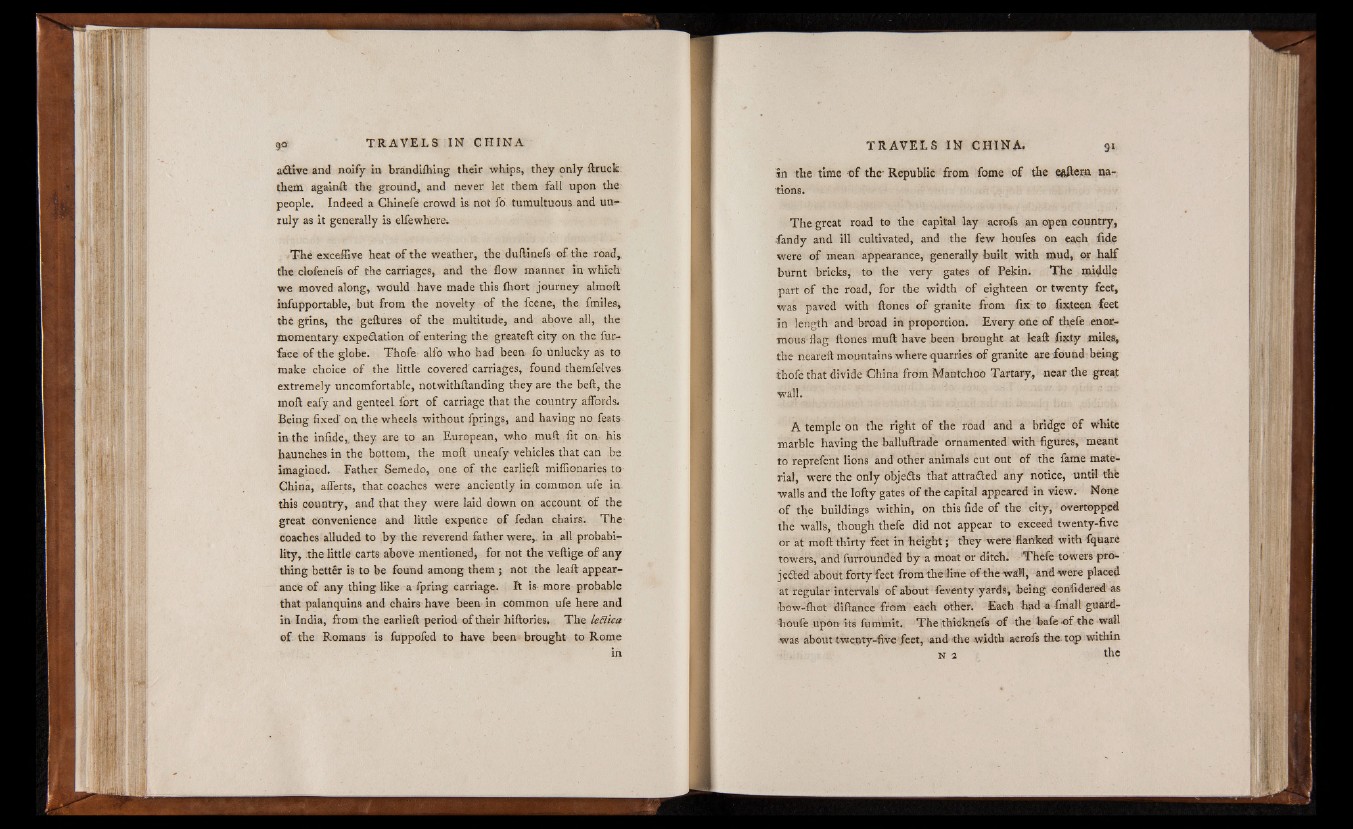
adlive and noify in brandiihing their whips, they only ftruck
them againft the ground, and never let them fall upon the
people. Indeed a Chinefe crowd is not fo tumultuous and untruly
as it generally is elfewhere.
T he exceffive heat o f the weather, the duftinefs o f the road,,
the clofenefs o f the carriages, and the flow manner in which
we moved along, would have made this ihort journey almoft
infupportable, but from the novelty o f the fcene, the fmiles,
the grins, the geftures o f the multitude, and above all, the
momentary expectation o f entering the greateft city on the fur-
face o f the globe. Thofe alfo who had been fo unlucky as to
make choice o f the little covered carriages, found themfelves
extremely uncomfortable, notwithftanding they are the beft, the
moll eafy and genteel, fort o f carriage that the country affords.
Being fixed' on the wheels without fprings, and having no feats
in the infide,, they are to an European, who muft fit on- his
haunches in the bottom, the moll uneafy vehicles that can be
imagined. Father Semedo, one o f the earlieft miffionaries to
China, aflerts, that coaches were anciently in common ufe in.
this country, and that they were laid down on account o f the
great convenience and little expente o f fedan chairs. The
coaches alluded to by the reverend father were,, in all probability,
the little carts above mentioned, for not the veftige o f any
thing better is to be found among them 5 not the leaft appearance
o f any thing like a fpring carriage. It is- more probable
that palanquins and chairs have been in common ufe here and
in India, from the earlieft period o f their hiftories. The leB'tca
o f the Romans is fuppofed to have been brought to Rome
in
an the time o f the- Republic from fotne o f the eaftern nations.
The great road to the capital lay acrofs an open country,
Sandy and ill cultivated, and the few houfes on each fide
were o f mean appearance, generally built with mud, or half
burnt bricks, to the very gates o f Pekin. T he middle
part o f the road, for the width o f eighteen or twenty feet,
was paved with ftones o f granite from fix to fixteen feet
in length and broad in proportion. Every otte o f thefe enormous
flag ftones muft have been brought at leaft fixty miles,
the neareft mountains where quarries o f granite are found being
thofe that divide China from Mantcho© Tartary, -near the great
wall.
A temple on the right o f the road and a bridge o f White
marble having the -balluftrade ornamented with figures, meant
to reprefent lions and other animals cut out o f the fame material,
were the only objedts that attra&ed any notice, until the
walls and the lofty gates o f the capital appeared in view. None
o f the buildings within, on this fide o f the city, overtopped
the walls, though thefe did not appear to exceed twenty-five
or at moft thirty feet in he ight; they were flanked with fquare
towers, and furrounded b y a moat or ditch. 'Thefe towers pro-
j c etc cl about forty'feet from the iline o f the w i ll, and were placed
at regular intervals o f about feventy yards, being considered -as
■bow-ihot diftance from each other. Each had a fmall guard-
houfe upon its fummit. The thiekftefs o f the bafe-of the wall
was about twenty-five feet, -and the -width acrofs the top within
N 2 th e